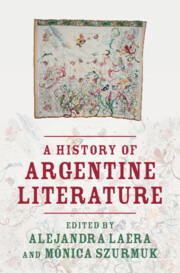Book contents
- A History of Argentine Literature
- A History of Argentine Literature
- Copyright page
- Contents
- Figures
- Contributors
- Editors’ Acknowledgments
- Introduction
- Part I Literary Dates
- Part II Critical Inroads
- Part III Literary Names
- Chapter 21 Sarmiento: Politics, Culture, and Spectacle
- Chapter 22 The Mansilla Siblings: A Story in Syntony
- Chapter 23 Martín Fierro: Subaltern Voices
- Chapter 24 Borges and Argentine Literature: A Detour around the World
- Chapter 25 Roberto Arlt
- Chapter 26 The Ocampo Sisters
- Chapter 27 Alfonsina Storni and Alejandra Pizarnik
- Chapter 28 Displacement and Transfer in Julio Cortázar’s Todos los fuegos el fuego
- Chapter 29 Manuel Puig’s Circuit Bending: Literary Listening against Surveillance
- Chapter 30 Operation Massacre: Dangerous Journalism
- Chapter 31 The Politics of the Poem: From Gelman to Perlongher
- Chapter 32 Scenes from Postmodern Life: Literary Interventions in the Public Sphere
- Chapter 33 Griselda Gambaro and Beyond: A “Dermography” of Contemporary Women’s Theater and Performance
- Chapter 34 César Aira and the Art of Invention
- Index
- References
Chapter 32 - Scenes from Postmodern Life: Literary Interventions in the Public Sphere
from Part III - Literary Names
Published online by Cambridge University Press: 09 May 2024
- A History of Argentine Literature
- A History of Argentine Literature
- Copyright page
- Contents
- Figures
- Contributors
- Editors’ Acknowledgments
- Introduction
- Part I Literary Dates
- Part II Critical Inroads
- Part III Literary Names
- Chapter 21 Sarmiento: Politics, Culture, and Spectacle
- Chapter 22 The Mansilla Siblings: A Story in Syntony
- Chapter 23 Martín Fierro: Subaltern Voices
- Chapter 24 Borges and Argentine Literature: A Detour around the World
- Chapter 25 Roberto Arlt
- Chapter 26 The Ocampo Sisters
- Chapter 27 Alfonsina Storni and Alejandra Pizarnik
- Chapter 28 Displacement and Transfer in Julio Cortázar’s Todos los fuegos el fuego
- Chapter 29 Manuel Puig’s Circuit Bending: Literary Listening against Surveillance
- Chapter 30 Operation Massacre: Dangerous Journalism
- Chapter 31 The Politics of the Poem: From Gelman to Perlongher
- Chapter 32 Scenes from Postmodern Life: Literary Interventions in the Public Sphere
- Chapter 33 Griselda Gambaro and Beyond: A “Dermography” of Contemporary Women’s Theater and Performance
- Chapter 34 César Aira and the Art of Invention
- Index
- References
Summary
Beatriz Sarlo’s Escena de la vida postmoderna represents a turning point in literary studies, cultural studies, and media studies in Argentina. Originally published in 1994, it was a major, influential intervention on cultural and media questions that had not been central in literary studies, written by a well-known literary scholar. It represents a shift from “the book” to “the city” as a site of analysis and interpretation of cultural forms. Part urban critic, part flâneur, Sarlo is intrigued by the changing public spaces of Buenos Aires amid a new phase of late capitalism, marked by new forms of consumerism, visual culture, and entertainment. She dissects the meanings and dynamics of cultural expressions that transcend and challenge the power of the written word, and unearths a new Buenos Aires, increasingly dominated by screens, public gatherings in private spaces, youth subcultures, and art forms that echo new developments. The book stands as both a call to fellow literary scholars to foreground nonliterary forms of cultural production and engagement in their work, and as a representation of an important point of reference to “demediatize” the study of communication and meaning-making in order to comprehend the significance of public and popular urban sites.
- Type
- Chapter
- Information
- A History of Argentine Literature , pp. 507 - 519Publisher: Cambridge University PressPrint publication year: 2024

